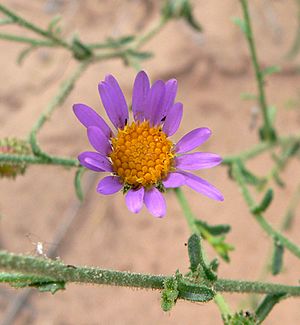Hoary tansyaster facts for kids
Quick facts for kids Hoary tansyaster |
|
|---|---|
 |
|
| Scientific classification | |
| Kingdom: | |
| (unranked): | |
| (unranked): | |
| (unranked): | |
| Order: | |
| Family: | |
| Genus: |
Dieteria
|
| Species: |
D. canescens
|
| Binomial name | |
| Dieteria canescens (Pursh) A.Gray
|
|
| Synonyms | |
|
Synonymy
Aster biennis Nutt.
Aster canescens Pursh Aster glossophyllus Piper Aster leiodes S.F.Blake Dieteria divaricata Nutt. Dieteria pulverulenta Nutt. Dieteria viscosa Nutt. Machaeranthera angustifolia Rydb. Machaeranthera divaricata (Nutt.) Greene Machaeranthera glabella Greene ex Rydb. Machaeranthera laetevirens Greene Machaeranthera latifolia A.Nelson Machaeranthera leptophylla Rydb. Machaeranthera linearis Rydb. 1900, not Greene 1897 Machaeranthera montana Greene Machaeranthera paniculata A.Nelson Machaeranthera pinosa Elmer Machaeranthera pulverulenta (Nutt.) Greene Machaeranthera ramosa A.Nelson Machaeranthera selbyi Rydb. Machaeranthera spinulosa (Greene) Cory Machaeranthera subalpina Greene Machaeranthera superba A.Nelson Machaeranthera viscosa (Nutt.) Greene Machaeranthera angustifolia Wooton & Standl. 1913, not Rydb. 1910, syn of var. ambigua Machaeranthera oxylepis Greene, syn of var. ambigua Machaeranthera scoparia Greene, syn of var. ambigua Machaeranthera cichoriacea, syn of var. aristata Machaeranthera rigida Greene, syn of var. aristata Aster linearis (Greene) Cory, syn of var. glabra Machaeranthera linearis Greene, syn of var. glabra Aster attenuatus (Howell) Frye & Rigg, syn of var. incana Aster attenuatus (Howell) M.Peck, syn of var. incana Dieteria incana (Lindl.) Torr. & A.Gray, syn of var. incana Diplopappus incanus Lindl., syn of var. incana Machaeranthera attenuata Howell, syn of var. incana Machaeranthera incana (Lindl.) Greene, syn of var. leucanthemifolia Aster leucanthemifolius Greene, syn of var. leucanthemifolia Machaeranthera hiemalis A.Nelson, syn of var. leucanthemifolia Machaeranthera leucanthemifolia (Greene) Greene, syn of var. leucanthemifolia Dieteria sessiliflora Nutt., syn of var. sessiliflora Machaeranthera magna A.Nelson, syn of var. sessiliflora Machaeranthera sessiliflora (Nutt.) Greene, syn of var. sessiliflora Aster eradiatus (A.Gray) Frye & Rigg, syn of var. shastensis Aster inornatus Greene Synonym, syn of var. shastensis Aster shastensis (A.Gray) A.Gray, syn of var. shastensis Machaeranthera eradiata (A.Gray) Howell, syn of var. shastensis Machaeranthera inops A.Nelson & J.F.Macbr., syn of var. shastensis Machaeranthera inornata (Greene) Greene, syn of var. shastensis Machaeranthera shastensis A.Gray, syn of var. shastensis |
|
Dieteria canescens (formerly known as Machaeranthera canescens) is a type of plant in the daisy family. It can be an annual (meaning it lives for one year) or a short-lived perennial (living for a few years). It is commonly called the hoary tansyaster or hoary-aster. The word "canescens" means "gray-hairy," which describes how the plant looks.
Contents
Where the Hoary Tansyaster Grows
This plant is native to a large area of western and central North America. You can find it from the Pacific Coast all the way to the western part of the Great Plains. Its range stretches from British Columbia in the north down to California, Sonora, and Chihuahua in the south. It also grows east to Saskatchewan, the Dakotas, and Oklahoma. Sometimes, small groups of these plants are found in Iowa and Minnesota.
How the Hoary Tansyaster Grows
The Dieteria canescens is a type of annual or perennial herb. It has a woolly, hairy texture and is also glandular, meaning it has small glands. It usually has one or more stems that branch out. These stems can sometimes grow taller than 100 cm (39 in) (about 39 inches).
Leaves and Stems
The leaves of the hoary tansyaster are long and narrow, or oblong (oval-shaped). Near the bottom of the stems, they can be up to 10 centimetres (3.9 inches) (about 4 inches) long. The edges of the leaves are usually serrated (like a saw blade) or toothed. The stems themselves are covered in short hairs and have glands.
Flowers and Seeds
The plant produces flower heads. Each flower head has several layers of pointed, curling leaves called phyllaries around the outside. In the center of the head, there are many yellow disc florets. These are surrounded by a ring of blue or purple ray florets, which look like petals. Each ray floret can be 1 to 2 centimeters long.
After the flowers bloom, they produce a fruit called an achene. This achene is about 3 millimeters long and has a pappus of long hairs on top. You can often see many different insects visiting these flowers.
Traditional Uses
The Zuni people, a Native American tribe, have traditionally used the Dieteria canescens plant. They would make an infusion (a type of herbal tea) from the whole plant of the canescens variety. This infusion was then rubbed on the abdomen as an emetic, which means it was used to cause vomiting.
Types of Hoary Tansyaster
There are several different types, or varieties, of Dieteria canescens found in various regions:
- Dieteria canescens var. ambigua – Found in Arizona, Colorado, New Mexico.
- Dieteria canescens var. aristata – Found in Arizona, Colorado, New Mexico, Utah.
- Dieteria canescens var. canescens – Found across a wide area including Alberta, British Columbia, Saskatchewan; Arizona, California, Colorado, Idaho, Montana, Nebraska, Nevada, North Dakota, Oregon, South Dakota, Utah, Wyoming.
- Dieteria canescens var. glabra – Found in Arizona, Colorado, Kansas, New Mexico, Texas, Wyoming, Chihuahua.
- Dieteria canescens var. incana – Found in Nebraska, South Dakota.
- Dieteria canescens var. leucanthemifolia – Found in California, Nevada, Utah.
- Dieteria canescens var. nebraskana – Found in Nebraska, South Dakota.
- Dieteria canescens var. sessiliflora – Found in Idaho.
- Dieteria canescens var. shastensis – Found in California, Nevada, Oregon.
- Dieteria canescens var. ziegleri – Found in the Santa Rosa Mountains in Riverside County in California.

